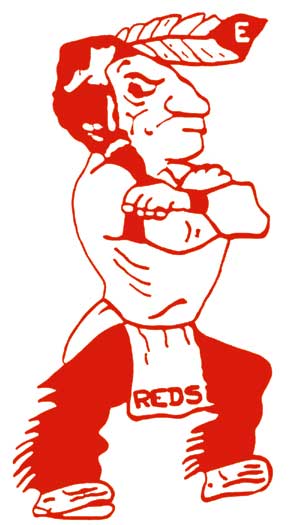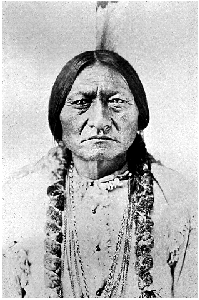
 A response to The Harm of Native Stereotyping: Facts and Evidence:
A response to The Harm of Native Stereotyping: Facts and Evidence:

 A response to The Harm of Native Stereotyping: Facts and Evidence:
A response to The Harm of Native Stereotyping: Facts and Evidence:
Rob,
Blue Corn is an interesting site. Perhaps a little too inflammatory for my taste, but interesting.
In my ten years of researching American Indian history and anthropology, many fascinating things have become clear:
1. Many Indian claims of Indian Stereotypes, are them selves Stereotypes as they are based on false assumptions: "Sioux", "Red Skin", "Native American", etc.
2. Approximately 75% of all American Indians (Algonquin) ancestry migrated to North America from Central Europe.
3. The use of American Indian mascots does much to keep American Indian culture alive. Perhaps the "Indian Movement" should focus on authenticity rather than bans. 3,000 years of recorded history is replete on the use of bans as the most effective way obliterate history.
4. Stereotypical White beliefs are a dieing breed. American Indian leaders and educators have never had more power to effect positive change than they do today. American Indian Culture in government, schools, books, magazines, music, language tapes. maps, Indian casinos, travel agencies, tour companies, jewelry, art, blankets, pottery, woven baskets, antiquities, and more, is more popular today than at anytime other time in history.
I believe that bashing the "other side" is counter-productive, a waste of time and resources.
Perhaps a positive embrace of the topic will enlist more believers, armies of them, all wanting to take part in what is one of North Americas true cultural treasures.
Please take a look at what I hope is a constructive attempt to convert the ignorant into believers: http://www.attractionmaps.com/nwac/images/sbmchieftains.html.
There are countless opportunities to publish educational materials that will educate the young and old alike.
Remember, virtually every individual on the planet will be dead in 70 years. The new inhabitants need a new perspective, wouldn't you agree?
Bob Sherby
Historical Map Publisher
Rob's reply
Bob,
Thanks for writing. A few comments:
>> 1. Many Indian claims of Indian Stereotypes, are them selves Stereotypes as they are based on false assumptions: "Sioux", "Red Skin", "Native American", etc. <<
How do your three examples qualify as "Indian claims"? They're all labels applied to Indians by non-Indians.
>> 2. Approximately 75% of all American Indians (Algonquin) ancestry migrated to North America from Central Europe. <<
A few Europeans may have migrated to North America. But enough to make up 75% of all Algonquian Indians? I don't think so. Where's the evidence for this?
Besides, the term "Native" is relative. People who have been here for 50,000 years rather than 500 years are "native" within the span of human history. They possessed the land before the beginning of government or law, so they have every right to it.
>> 3. The use of American Indian mascots does much to keep American Indian culture alive. <<
No, it doesn't. This is an opinion, not a fact. Give me some examples of Indian culture being kept alive via a mascot.
>> 4. Stereotypical White beliefs are a dieing breed. <<
Yes, thanks to the many people who have challenged and protested them.
>> I believe that bashing the "other side" is counter-productive, a waste of time and resources. <<
Read a sampling of comments from the thousands of people who disagree with you:
My website is getting something like 60,000 hits a day, or 20 million hits a year. That's a ton of people being educated. How is your website doing?
>> Perhaps a positive embrace of the topic will enlist more believers, armies of them, all wanting to take part in what is one of North Americas true cultural treasures. <<
My embrace is positive, since I'm promoting genuine Native cultures instead of phony Native stereotypes. The readership of my website, newsletter, and blog are all increasing, so there's your army of believers for you.
>> Please take a look at what I hope is a constructive attempt to convert the ignorant into believers: http://www.attractionmaps.com/nwac/images/sbmchieftains.html. <<
Looks good.
In case you weren't aware, I also publish Native American-themed comics. I imagine they're as constructive as your map is. So not only am I criticizing what's wrong, I'm publishing what I consider right.
>> There are countless opportunities to publish educational materials that will educate the young and old alike. <<
Yes, and I'm taking advantage of those opportunities with PEACE PARTY and the many articles I write.
>> Remember, virtually every individual on the planet will be dead in 70 years. The new inhabitants need a new perspective, wouldn't you agree? <<
Yes, which is why I promote a Native and multicultural perspective in everything I do. Read my essay at Culture and Comics Need Multicultural Perspective 2000 and learn more about my mission.
Rob Schmidt
Publisher
PEACE PARTY
The debate continues (7/20/07)....
>> In #2, I recently read an article published in National Geographic or Scientific American (I have misplaced the article but will find it) that was the result of DNA samples taken from American Indians both living and not. The study found that 75% of approximately 1000 subjects tested throughout North America had at Algonquin genetic heritage and that 25% of those subjects had Eastern European genetics. The study conclusion was that the only way that 25% of any tribe's generic makeup could have Eastern European genetics would be that approximately 10,000 years ago, there was a migration. <<
Anything this provocative would've been reported and discussed widely on the Web. If you can't find the original article, find the reports or discussions of it online. I searched and I couldn't find anything, so I remain skeptical.
>> Rather than comparing numbers of mascots, perhaps it would be more productive to ask you if you felt that if people showed more sensitivity to the portrayal of culture, it would be a good thing? <<
Yes. But since the two options aren't mutually exclusive, we don't have to choose between them.
>> My point here is that I changed my thinking about all minorities with out being confronted by angry protestors. In fact, the majority of my friends are now like-minded. It was EDUCATION and CONTACT that PURSATED me change. <<
That's nice, but it's hardly relevant. The counterexamples to your anecdote are numerous.
The most obvious is the civil rights movement. Americans rethought their positions about blacks only after marches and boycotts and forced integration.
Indians have been airing their grievances publicly since the 1970s. Even if you don't think their protests influenced you, you probably heard or read about them.
Since I quote Native people as much as possible, visitors are getting contact with Native viewpoints even if I'm not Native. They're learning exactly what I've learned about how Natives think and feel.
In short, I'm a calm educator, not an angry protester. I explain why people are wrong about, say, mascots with facts, evidence, and logic.
Since I'm not marching in the streets or advocating boycotts, your criticism doesn't apply to me. I'm doing exactly what you think I should be doing.
>> My only quest is to teach people to use education to persuade, not confrontation. <<
Confronting people with uncomfortable facts and evidence is a common way to educate them. The conflict between their preconceived beliefs and the objective evidence persuades them to rethink their positions.
In other words, there's no difference between confrontation and persuasion in many cases. Sometimes they're identical or inseparable; other times they're two steps along the path to enlightenment.
I trust I don't have to trot out examples of teachers confronting students with "truths" they never imagined. You've probably had this experience...but if you haven't, the rest of us have.
For instance, the whole Socratic method is based upon confrontation. It persuades through confrontation, as the teacher questions and challenges the student's beliefs. Here's how Wikipedia describes it:
Generally this involves the defense of one point of view against another and is oppositional. The best way to 'win' is to make the opponent contradict themselves in some way that proves the inquirer's own point.
Rob
|
. . . |

|
All material © copyright its original owners, except where noted.
Original text and pictures © copyright 2007 by Robert Schmidt.
Copyrighted material is posted under the Fair Use provision of the Copyright Act,
which allows copying for nonprofit educational uses including criticism and commentary.
Comments sent to the publisher become the property of Blue Corn Comics
and may be used in other postings without permission.